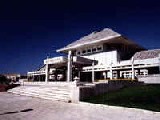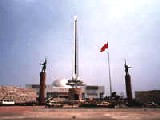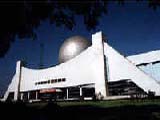Tianjin Arts and CultureIt is no exaggeration to say that Tianjin bears a splendid historical background. Before the foundation of People's Republic of China, Tianjin was shared by nine countries including Italy, Germany, France, Russia, Great Britain, Austria, Japan and Belgium. This marked an extremely hard period for Tianjin and its people because those imperialist countries left permanent marks in her body, most notable of which were thousands of villas. But today those villas provide an exotic flavor to Tianjin, enhancing the beauty of the entire city. Tianjin has honest and simple social customs and morals; its folk culture and art are long respected and uniquely enchanting. Tianjin with its colourful history is endowed with deep cultural connotations which have inspired some famous recreational art forms such as cross-talk, Jingyun Dagu, and Tianjin Kuaiban being the most famous. Usually Tianjin Kuaiban is performed in the Tianjin dialect. The performer (or performers) follows the rhythm coming from two thin bamboo boards on his hand. People can enjoy those traditional art forms mentioned above in some of theatres in Tianjin. Other than operatic performances, Tianjin offers an array of cultural related activities for visitors
The Tianjin Peking Opera Troupe has a strong lineup. It is one of the most important performing artistic troupe's of the Peking Opera in China. In the Tianjin Peking Opera Troupe a lot of outstanding and talented performers and musicians work tirelessly in order to provide the best Chinese Peking Opera performances to the point where in the past 40 years, the reputation of old and new artists of the troupe has spread around the whole world showcasing their strength and skill while performing their rich and varied performances. The Troupe has their very own distinctive artistic style which they have developed into an art form which is considered a uniquely Chinese national art form.
TEstablished in 1985, the Tianjin Orchestra is one of China's largest orchestras. The orchestra now has 11 national first grade and 30 national second grade musicians. Since it began, the orchestra has rehearsed and performed a lot of world famous works of music, and collaborated with over 50 famous conductors and musicians from home and abroad. The Ministry of Culture of China commended the orchestra several times in the past years, because the orchestra has made a brilliant to the development of symphony music.
The Tianjin Song and Dance Group is one of the large scales, comprehensive, artistic and performing ensembles in China. Over the past half century, it has formed into three parts: ballet, national song and dance, and orchestral music, with a strong cast of 400 of performers and musicians. In recent years, the theatre has performed a lot of grand song and dance shows including "Enchantment of Tang and Song Dynasties", "The God of Sea", "The Arabian Nights", "The wisdom Light in the Orient", and "Spartacus". Besides presenting high-grade opera and dance shows, the Tianjin Song and Dance Group helped to open up the overseas performing market, making great contribution in promoting international cultural exchange.
Tianjin Concert Hall
People's Theatre Minzhu Theatre Zhonghua Quyi Theatre
Tianjin's best known scenic spots and historical sites include the Panshan Scenery Area, the Park on the Water, the Garden of Tranquility, the Tianhou Palace (Palace of Heavenly Empress), the Dule Temple (Solitary Joy Temple), the Great Wall at the Huangya Pass, and so on. The Ancient Culture Street lies on the junction of three rivers and is the centre of ancient Tianjin. With a Mazu Temple in its center, it is the cradle of Tianjin's riverside culture. The Great Wall, running through Jixian County to the north of Tianjin also adds to the city's primitive simplicity and charm.
The Food Street in Tianjin's Southern Market looks like an ancient walled city enclosed by a circle of neat three-story buildings. There is a crossroads and at the centre of the crossroads is a musical fountain. The entire structure is covered with a glass roof. In Food Street are over 100 eating places, occupying more than 40,000 square meters in floor space and each having its own special dishes of local flavors. There are Chinese restaurants serving Tianjin and other schools of cuisine and Western restaurants. As a large city, Tianjin can indulge you with almost all eight of the classical Chinese cuisines, of which seven types including Shandong, Jiangsu, Sichuan, Anhui, Guangdong, Zhejiang, and Hunan Cuisines can be enjoyed in Food Street. Undoubtedly each cuisine is a feast for your pallet. What's more all the traditional Chinese constructions are also represented in this street making a feast for your eyes as well.
Situated next to the Hotel Street, the Clothing Street is the abbreviated name of the Tianjin Clothing Display and Sales Centre. Altogether there are over 100 shops in the Clothing Street which is operated by the state, collectives, or individuals. The stores offer famous, special and new clothes, in both retail and wholesale.
Zhou Enlai and Deng Yingchao Memorial Hall
Museum of the Beiping-Tianjin Campaign
The battle form November 29, 1948 and January 31, 1949 held over a battle front of 500 kilometers (from Tangshan in the east to Zhangjiakou in the west) against the Kuomintang forces in North China was over a million strong. Victory in the Beiping-Tianjin Campaign and in the Liaoxi-Shenyang and Huaihai campaigns ensured victory in the War of Liberation in the whole of China. The Museum of the Beiping-Tianjin Campaign is on the western side of the bridge over the Ziya River in Tianjin. The museum occupies 47,000 square meters and was opened to the public on August 1, 1997. Tianjin Museum of Science and Technology
Construction of the museum began in 1992, with the museum opening to the public on New Year's Day, 1995. This modern comprehensive museum is equipped for the popularization of science and is one of the largest of its kind in the world. Tianjin Natural History Museum
Zhujiang Cinema Yan'an Cinema Tianjin Cinema Tanggu Cultural Centre Cinema Shuguang Cinema Qunzhong Cinema Nankai Cinema Jingjin Cinema Jinzhong Cinema Huanghe Road Cinema Huaihai Cinema Hongqi Cinema Heping Cinema Guangming Cinema Bayi Auditorium Cinema Beijing Cinema |

 Covering
an area of 6,600 square meters, the Zhou Enlai and Deng Yingchao
Memorial Hall by the north side of Water Park was opened on March
5, 1998 to commemorate the centenary of the birth of the late Premier
Zhou Enlai. Included in the building are an entrance hall, exhibition
rooms that illustrate Zhou's life with historical photographs, his
correspondences and personal collection, a video show room, a multi-purpose
hall, distinguished guests' lounge, and a library of archives.
Covering
an area of 6,600 square meters, the Zhou Enlai and Deng Yingchao
Memorial Hall by the north side of Water Park was opened on March
5, 1998 to commemorate the centenary of the birth of the late Premier
Zhou Enlai. Included in the building are an entrance hall, exhibition
rooms that illustrate Zhou's life with historical photographs, his
correspondences and personal collection, a video show room, a multi-purpose
hall, distinguished guests' lounge, and a library of archives.  The
Beiping-Tianjin Campaign was a large-scale strategically decisive
battle which, under the guidance of the Chinese Communist Party,
was fought by the Northeast Field Army and the North China Field
Army of the PLA.
The
Beiping-Tianjin Campaign was a large-scale strategically decisive
battle which, under the guidance of the Chinese Communist Party,
was fought by the Northeast Field Army and the North China Field
Army of the PLA.  The
Tianjin Museum of Science and Technology is located in Longchang
Road, Hexi District, next to the Tianjin Amusement Park. It occupies
40,000 square meters.
The
Tianjin Museum of Science and Technology is located in Longchang
Road, Hexi District, next to the Tianjin Amusement Park. It occupies
40,000 square meters. 
